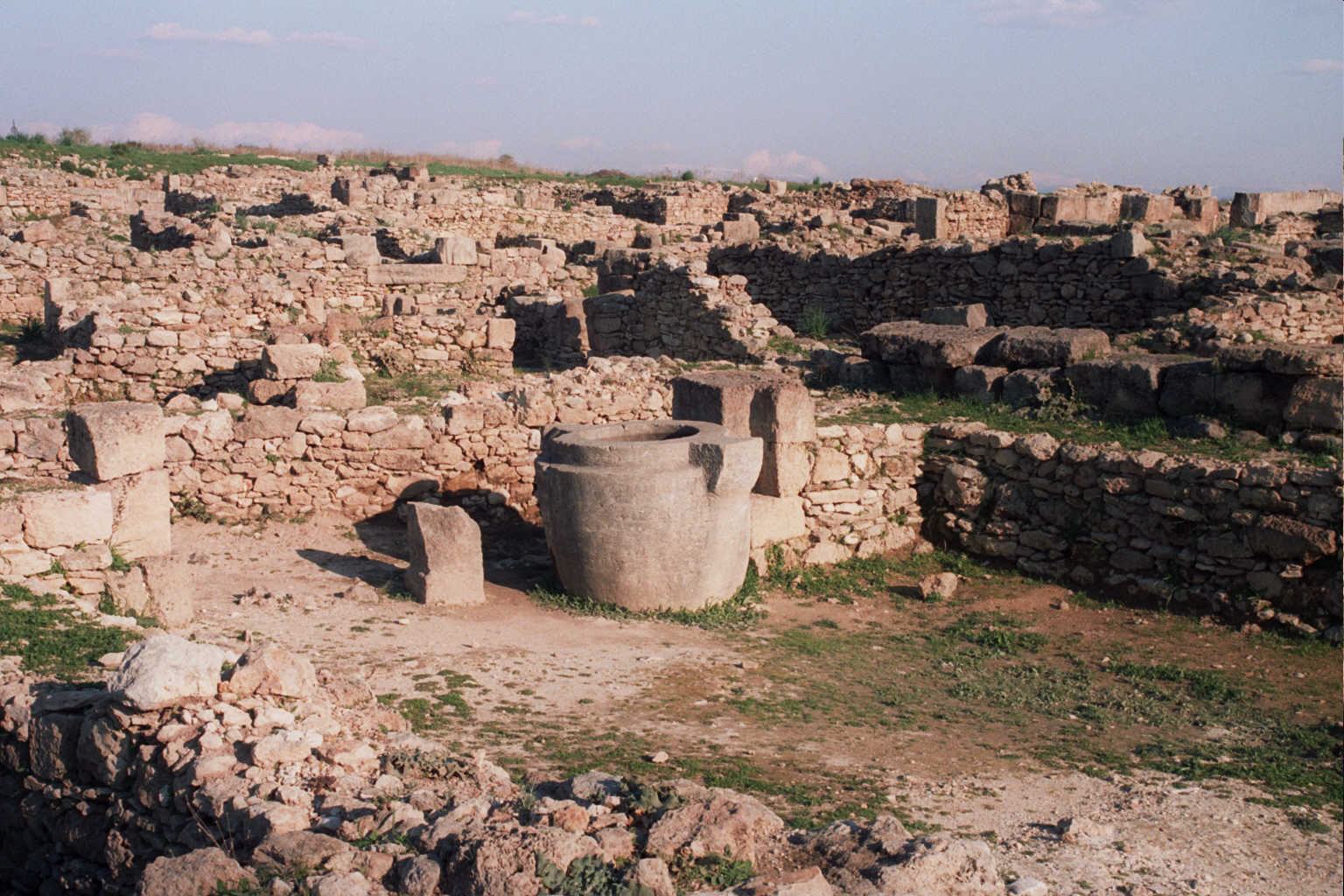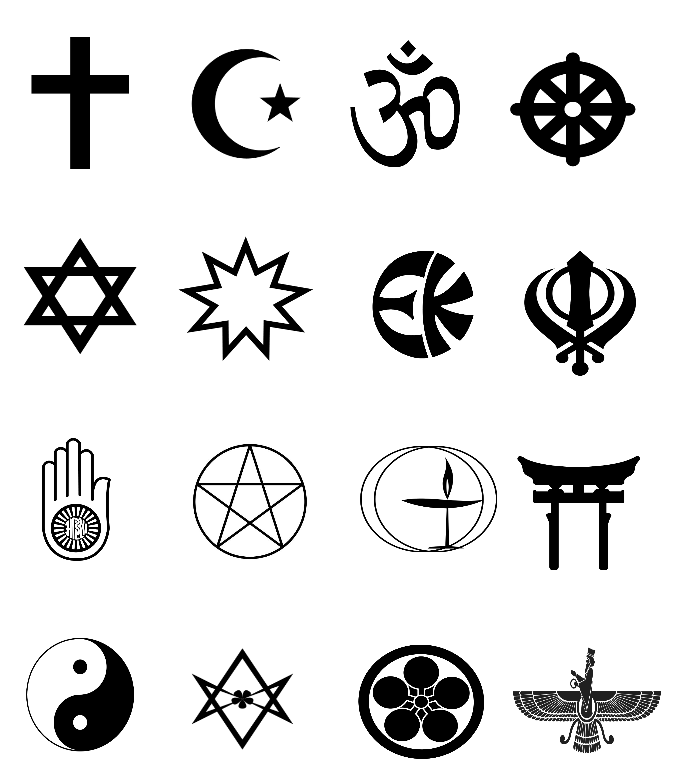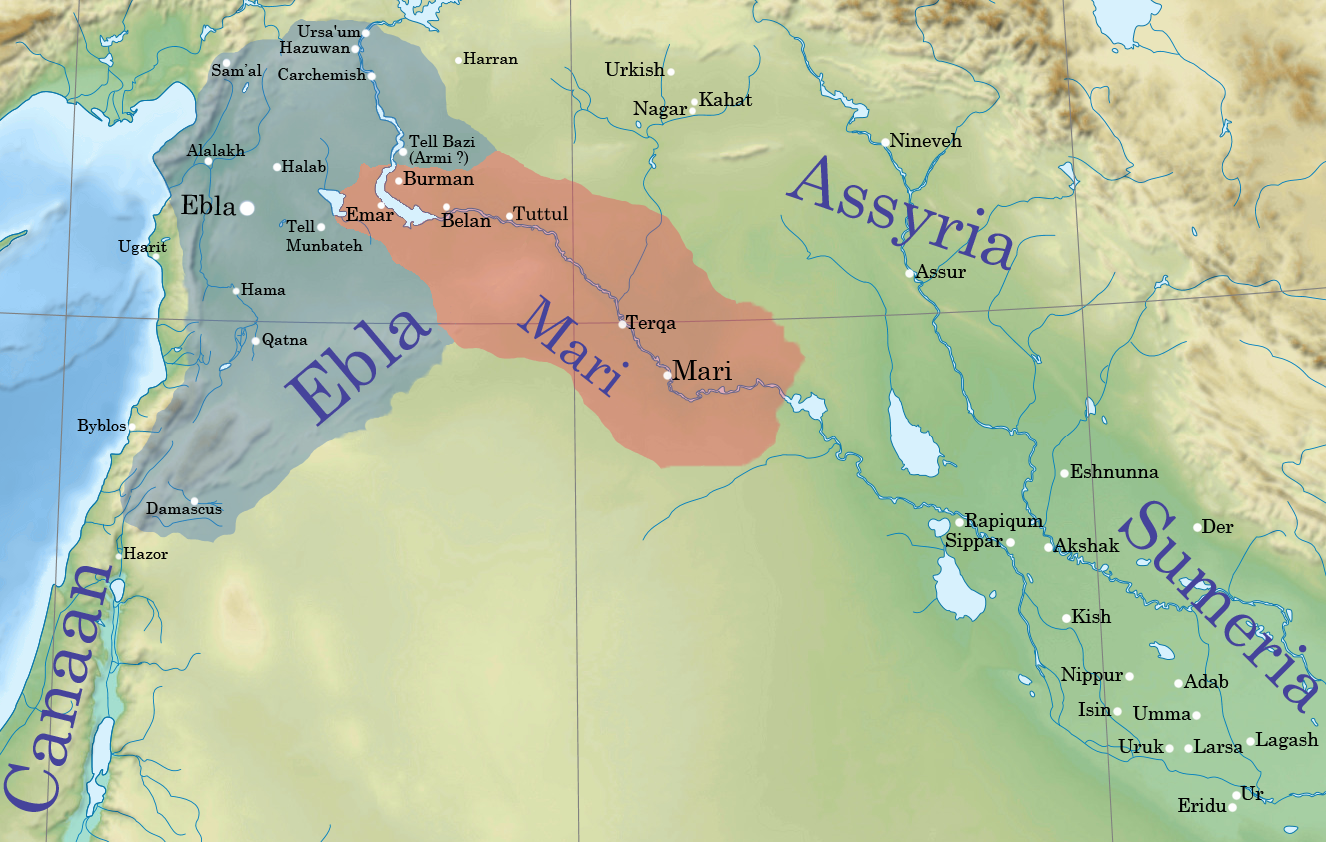|
Levantine Mythology
Canaanite religion or Syro-Canaanite religions refers to the myths, cults and ritual practices of people in the Levant during roughly the first three millennia BC. Canaanite religions were polytheistic and in some cases monolatristic. They were influenced by neighboring cultures, particularly ancient Egyptian and Mesopotamian religious practices. The pantheon was headed by the god El and his consort Asherah, with other significant deities including Baal, Anat, Astarte, and Dagon. Canaanite religious practices included animal sacrifice, veneration of the dead, and the worship of deities through shrines and sacred groves. The religion also featured a complex mythology, including stories of divine battles and cycles of death and rebirth. Archaeological evidence, particularly from sites like Ugarit, and literary sources, including the Ugaritic texts and the Hebrew Bible, have provided most of the current knowledge about Canaanite religion. Sources and history Knowledge about ... [...More Info...] [...Related Items...] OR: [Wikipedia] [Google] [Baidu] |
Religion
Religion is a range of social system, social-cultural systems, including designated religious behaviour, behaviors and practices, morals, beliefs, worldviews, religious text, texts, sanctified places, prophecies, ethics in religion, ethics, or religious organization, organizations, that generally relate humanity to supernatural, transcendence (religion), transcendental, and spirituality, spiritual elements—although there is no scholarly consensus over what precisely constitutes a religion. It is an essentially contested concept. Different religions may or may not contain various elements ranging from the divine, sacredness, faith,Tillich, P. (1957) ''Dynamics of faith''. Harper Perennial; (p. 1). and a supernatural being or beings. The origin of religious belief is an open question, with possible explanations including awareness of individual death, a sense of community, and dreams. Religions have sacred histories, narratives, and mythologies, preserved in oral traditions, sac ... [...More Info...] [...Related Items...] OR: [Wikipedia] [Google] [Baidu] |
Amorites
The Amorites () were an ancient Northwest Semitic languages, Northwest Semitic-speaking Bronze Age people from the Levant. Initially appearing in Sumerian records c. 2500 BC, they expanded and ruled most of the Levant, Mesopotamia and parts of Egypt from the 21st century BC to the late 17th century BC. The Amorites established several prominent city-states in various locations, such as Isin, Kurda, Larsa, Mari, Syria, Mari, and Ebla, and later founded Babylon and the Old Babylonian Empire. They also founded the Fourteenth Dynasty of Egypt during the fragmented era of the Second Intermediate Period of Egypt, Second Intermediate Period in the Nile Delta, which was characterized by rulers bearing Amorite names such as Yakbim Sekhaenre, and were likely part of the later Hyksos. The term in Akkadian and Sumerian texts refers to the Amorites, Amurru (god), their principal deity, and Amurru kingdom, an Amorite kingdom. The Amorites are mentioned in the Hebrew Bible as inhabitants of Ca ... [...More Info...] [...Related Items...] OR: [Wikipedia] [Google] [Baidu] |
Theophoric Name
A theophoric name (from Greek: , ''theophoros'', literally "bearing or carrying a god") embeds the word equivalent of 'god' or a god's name in a person's name, reflecting something about the character of the person so named in relation to that deity. For example, names embedding Apollo, such as ''Apollonios'' or ''Apollodorus'', existed in Greek antiquity. Theophoric personal names, containing the name of a god in whose care the individual is entrusted (or a generic word for ''god''), were also exceedingly common in the ancient Near East and Mesopotamia Mesopotamia is a historical region of West Asia situated within the Tigris–Euphrates river system, in the northern part of the Fertile Crescent. Today, Mesopotamia is known as present-day Iraq and forms the eastern geographic boundary of .... Some names of theophoric origin remain common today, such as Theodore (given name), Theodore (''theo-'', "god"; ''-dore'', origin of word compound in Greek: ''doron'', "gift"; he ... [...More Info...] [...Related Items...] OR: [Wikipedia] [Google] [Baidu] |
Ebla
Ebla (Sumerian language, Sumerian: ''eb₂-la'', , modern: , Tell Mardikh) was one of the earliest kingdoms in Syria. Its remains constitute a Tell (archaeology), tell located about southwest of Aleppo near the village of Mardikh. Ebla was an important center throughout the and in the first half of the Its discovery proved the Levant was a center of ancient, centralized civilization equal to Ancient Egypt, Egypt and Mesopotamia and ruled out the view that the latter two were the only important centers in the Ancient Near East, Near East during the Early Bronze Age. The first Eblaite kingdom has been described as the first recorded world power. Starting as a small settlement in the Early Bronze Age ( ), Ebla developed into a trading empire and later into an expansionist power that imposed its hegemony over much of northern and eastern Syria. Ebla was destroyed during the It was then rebuilt and was mentioned in the records of the Third Dynasty of Ur. The second Ebla w ... [...More Info...] [...Related Items...] OR: [Wikipedia] [Google] [Baidu] |
Ebla Tablets
The Ebla tablets are a collection of as many as 1,800 complete clay tablets, 4,700 fragments, and many thousands of minor chips found in the palace archives of the ancient city of Ebla, Syria. The tablets were discovered by Italian archaeologist Paolo Matthiae and his team in 1974–75 during their excavations at the ancient city at Tell Mardikh. The tablets, which were found ''in situ'' on collapsed shelves, retained many of their contemporary clay tags to help reference them. They all date to the period between c. 2500 BC and the destruction of the city c. 2250 BC.Dumper; Stanley, 2007, p.141. Today, the tablets are held in museums in the Syrian cities of Aleppo, Damascus, and Idlib. Discovery and archaeological context The tablets were discovered just where they had fallen when their wooden shelves burned in the final conflagration of "Palace G". The archive was kept in orderly fashion in two small rooms off a large audience hall (with a raised dais at one end); one reposito ... [...More Info...] [...Related Items...] OR: [Wikipedia] [Google] [Baidu] |
Ugarit 02
Ugarit (; , ''ủgrt'' /ʾUgarītu/) was an ancient port city in northern Syria about 10 kilometers north of modern Latakia. At its height it ruled an area roughly equivalent to the modern Latakia Governorate. It was discovered by accident in 1928 with the Ugaritic texts. Its ruins are often called Ras Shamra after the headland where they lie. History Ugarit saw its beginnings in the Neolithic period, the site was occupied from the end of the 8th millennium BC and continued as a settlement through the Chalcolithic and Bronze Ages. It was during the late bronze age that Ugarit experienced significant growth, culminating in the establishment of the Kingdom of Ugarit. The city had close connections to the Hittite Empire, in later times as a vassal, sent tribute to Egypt at times, and maintained trade and diplomatic connections with Cyprus (then called Alashiya), documented in the archives recovered from the site and corroborated by Mycenaean and Cypriot pottery found there. The po ... [...More Info...] [...Related Items...] OR: [Wikipedia] [Google] [Baidu] |
Damascius
Damascius (; ; 462 – after 538), known as "the last of the Athenian Neoplatonists", was the last scholarch of the neoplatonic Athenian school. He was one of the neoplatonic philosophers who left Athens after laws confirmed by emperor Justinian I forced the closure of the Athenian school in c. 529 AD. After he left Athens, he may have sought refuge in the court of the Persian King Chrosroes, before being allowed back into the Byzantine Empire. His surviving works consist of three commentaries on the works of Plato, and a metaphysical text entitled ''Difficulties and Solutions of First Principles''. Life Much of what is known about Damascius' life comes from his semi-autobiographical work called ''The Philosophical History'', or ''Life of Isidore'', and from a work called ''Vita Severi'' written by the 6th-century bishop and historian Zacharias Scholasticus. Damascius, as his name suggests, was born in Damascus in c. 462 AD, and travelled to Alexandria in the 480s AD to ... [...More Info...] [...Related Items...] OR: [Wikipedia] [Google] [Baidu] |
On The Syrian Goddess
''On the Syrian Goddess'' (; ) is a Ancient Greek, Greek treatise of the second century AD which describes religious cults practiced at the temple of Hierapolis Bambyce, now Manbij, in Syria. The work is written in a Herodotus, Herodotean style of Ionic Greek, and has been traditionally ascribed to the Syria (region), Syrian essayist Lucian of Samosata. Authorship Lucian has the reputation of being a witty scoffer, thanks to his many genuine essays and dialogues, and thus the reliability of ''De Dea Syria'' as an authentic picture of religious life in Syria in the second century has been brought into question, but given the possibility that Lucian is not in fact the author, the treatise may in fact be more accurate than was previously supposed. A more recent analysis concludes that Lucian is in fact the author but that this does not preclude historical accuracy.Lightfoot, ''De Dea Syria'' (2003) Summary ''De Dea Syria'' describes the worship as being of a phallic character, wi ... [...More Info...] [...Related Items...] OR: [Wikipedia] [Google] [Baidu] |
Lucian
Lucian of Samosata (Λουκιανὸς ὁ Σαμοσατεύς, 125 – after 180) was a Hellenized Syrian satirist, rhetorician and pamphleteer who is best known for his characteristic tongue-in-cheek style, with which he frequently ridiculed superstition, religious practices, and belief in the paranormal. Although his native language was probably Syriac, all of his extant works are written entirely in ancient Greek (mostly in the Attic Greek dialect popular during the Second Sophistic period). Everything that is known about Lucian's life comes from his own writings, which are often difficult to interpret because of his extensive use of sarcasm. According to his oration ''The Dream'', he was the son of a lower middle class family from the city of Samosata along the banks of the Euphrates in the remote Roman province of Syria. As a young man, he was apprenticed to his uncle to become a sculptor, but, after a failed attempt at sculpting, he ran away to pursue an educati ... [...More Info...] [...Related Items...] OR: [Wikipedia] [Google] [Baidu] |
Levantine Archaeology
Levantine archaeology is the archaeological study of the Levant. It is also known as Syro-Palestinian archaeology or Palestinian archaeology (particularly when the area of inquiry centers on ancient Palestine (region), PalestineOn page 16 of his book, Rast notes that the term Palestine (region), Palestine is commonly used by archaeology, archaeologists in Jordan and Israel to refer to the region encompassed by modern-day Israel, Jordan and the West Bank. On page ix, he defines "ancient Palestine" the same way but also includes the Gaza Strip.). Besides its importance to the discipline of Biblical archaeology, the Levant is highly important when forming an understanding of the history of the earliest peoples of the Stone Age. Current archaeological digs in Israel are carried out by the Israel Antiquities Authority (IAA), and in the areas governed by the Palestinian Authority (PA), by its Ministry of Tourism and Antiquities (Palestine), Ministry of Tourism and Antiquity, working und ... [...More Info...] [...Related Items...] OR: [Wikipedia] [Google] [Baidu] |
Hebrew Bible
The Hebrew Bible or Tanakh (;"Tanach" . '' Random House Webster's Unabridged Dictionary''. ; ; or ), also known in Hebrew as (; ), is the canonical collection of scriptures, comprising the Torah (the five Books of Moses), the Nevi'im (the Books of the Prophets), and the [...More Info...] [...Related Items...] OR: [Wikipedia] [Google] [Baidu] |





